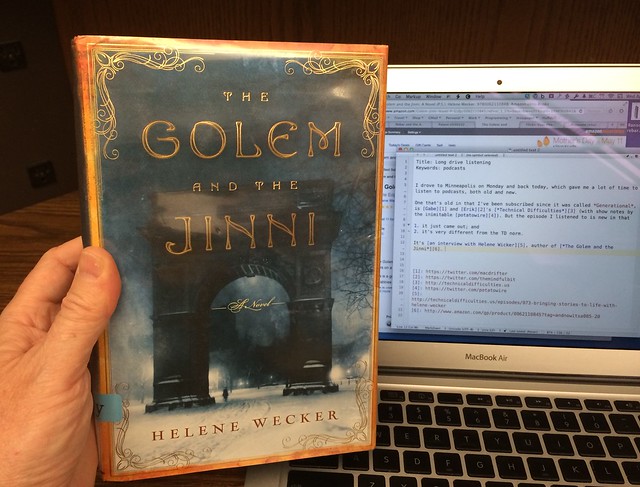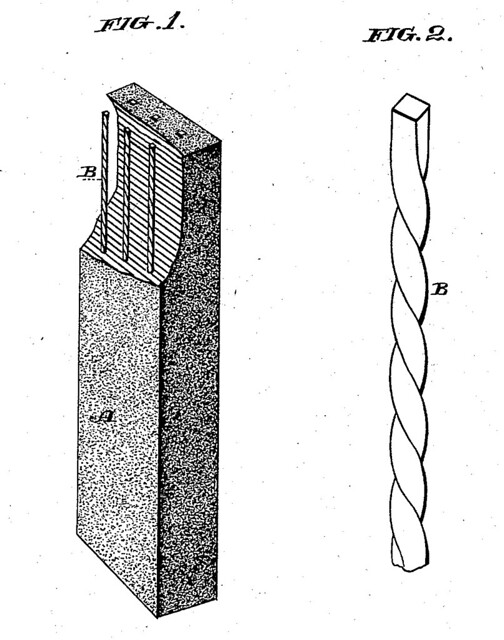Long drive listening
April 23, 2014 at 10:43 PM by Dr. Drang
I drove to Minneapolis on Monday and back today, which gave me a lot of time to listen to podcasts, both old and new.
One that’s old, in that I’ve been subscribed since it was called Generational, is Gabe and Erik’s Technical Difficulties (with show notes by the inimitable potatowire). But the episode I listened to today is new in that:
- It just came out.
- It’s very different from the TD norm.
It’s an interview with Helene Wecker, author of The Golem and the Jinni. She’s a great interviewee (probably had a lot of practice over the past year or so), with interesting stories about the research for the book and the many, many drafts she went through. The hour flew by.1
As it happens, I put The Golem and the Jinni on hold at the library a week or two ago and got a notice that it was waiting for me this morning. I just picked it up.
One of Wecker’s stories I enjoyed was about her listening to the Audible audiobook, narrated by George Guidall, and cringing at some of her earliest prose in the book—stuff that hadn’t gone through a cycle or two of polishing. She wished Guidall had narrated the book before it was published, so she could hear the clunkers and get rid of them.
I was reminded of something Lester del Rey said in The Early Del Rey.2 When he was done reworking a story, he’d always type up a final copy from start to finish. He believed that by typing the entire thing in the same order it’d be read, he could smooth over any clumsiness that had crept in when adjacent sentences were written days or weeks apart.3 This was, of course, in the days of the manual typewriter, when typing was a little harder, but editing was much harder. I can’t imagine anyone doing that on a computer.
A podcast that’s been around a while but is new to me is 99% Invisible with the improbably named Roman Mars. My wife sent me a link to this recent episode about William LeMessurier’s structural design of the Citicorp Center and his heroic response when he learned—after it was built—that its wind-bracing system was woefully inadequate. It’s a good story, and the episode tells it very well. I hope to write a post about it after I learn a few more details about LeMessurier’s original design.
I put a bunch of 99% Invisible episodes on my phone for the trip and listened to all of them. One of the older ones I really liked was about the Alvord Lake Bridge in San Francisco, the first structure built with something like modern reinforced concrete. Its designer, Ernest Ransome, used twisted iron bars for reinforcement. The twists gave the bars a mechanical interlock with the surrounding concrete, improving the bond between the two materials and making them work as a unit. Here are the two drawings of the system from Ransome’s patent.4
Image excerpted from Google’s patent page.
We don’t use twisted bars anymore, but the deformations on the surface of today’s rebar serve the same purpose.
The story of twisted rebar had a particular resonance with me. Some twenty years ago, I walked into the office of a friend, a fellow structural engineer, and his eyes lit up. “You’re going to like this,” he said.
He reached behind his desk and pulled out a short length of twisted rebar, just like what you see in the drawing above. He put it in my hands. “You are holding,” he said, “a piece of Frank Lloyd Wright’s rebar.” He might just as well have told me it was a fragment of the True Cross.
My friend was a well-known concrete expert in Chicago, and at the time he was working on the restoration of Wright’s Unity Temple, a building built in the first decade of the 20th century. Some of the temple’s reinforced concrete was being replaced during one of his visits to the site, and he snagged the rebar before it was disposed of. An unassuming but fun piece of architectural history—something Roman Mars would, I think, appreciate.
-
The episode is about a hundred minutes long, but I didn’t listen to the last 15 to 20 because they were moving into spoiler territory. ↩
-
I feel certain this is the only Mac-centric blog that has two posts in which Lester del Rey figures prominently. ↩
-
I’m continually amazed at the odd things that have stuck in my head. I read that book when it came out in ’76 and haven’t read it since. Why have I retained that passage? And why can’t I remember the names of our neighbors? ↩
-
A hundred years ago, reinforced concrete was in its infancy, and patents on new techniques and devices were common. Contrary to what you might think if you listen to the opinions of ⅔ of a certain tech podcast, this plethora of patents didn’t stifle innovation. Reinforced concrete construction flourished and soon became ubiquitous. ↩


